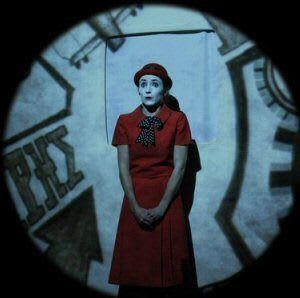The Christmas before last, theatre company 1927 had a hit here at the BAC with Between the Devil and the Deep Blue Sea, a macabre, technically outstanding show which showed how far the possibilities might go in terms of the interaction between live performers and projected film. Their new show proves that no-one has since taken those possibilities and pushed them further than 1927 themselves. The Animals and Children Took to the Streets differs from the previous show mainly in that the animated film is in colour, and is much more vibrant, complex and detailed than Between the Devil's simple, monochrome gothic stylings. The interplay between actors and film was always impressive, but now the company seem to luxuriate in the endless opportunities that this format allows them, and so there are countless witty touches that the audience sometimes barely registers before they are gone in a flash of pixels.
Three blank white screens arranged in a slight curve is the extent of the staging; behind one sits the marvellous Lillian Henley on the piano, also peeking out of an optional window in her screen to play various small parts. What's impressive is how the show uses every part of the stage, with a stream of animation projected constantly across all three screens. These are the main points of focus, and then there are a couple of other things always happening on the periphery, causing ripples of giggles to run through the audience, as some people spot something that others don't. Animated insects crawl across the screens; rabid children cause chaos in every corner; a pictorial cat shivers under the strokes of a human hand.
We're in an unnamed city, and the Bayou is the district that the rest of the city shuns. It's a place of crowded, stinking tenement blocks - rooms with "not enough room to swing a rat" - prying neighbours, dodgy junk shops, and children who are out of control. Sweet Agnes Eves ventures into this heart of darkness with her daughter Evie, to try and reform the Bayou children through love, patience and art classes - "dried pasta bows and PVA glue". Of course she fails, and meanwhile the children are running riot, and, under the leadership of pint-size revolutionary Zelda, are spilling out of their own district and smashing up the picturesque parks and boulevards of the city's public face. So the powers that be dream up a dastardly plan to subdue the little terrors, and it's into this plot that poor innocent Evie gets pulled.
The script is cleverly stylised, often rhymes, and makes good use of a chorus of prying neighbours to move the story along and provide musical interludes. The musical sequence introducing Mrs Villicar's junk shop is a rip-roaring number; brutally cut short at one point when the silhouettes of policemen loom over the shopfront and the performers run for cover.
The world of the show is a curious mix of vintage and contemporary, a world of bowler hats and old-fashioned ambulances but also of television and Kit Kats. It's surely deliberate, because it allows the company to have such fun with spinning out their tales in their ornate style, and then deflating them with some jarring contemporary reference.
The one element which doesn't quite fit is their trademark cut-glass English accents ("we are going to give you art with a capital Ah", is the proclamation at the start); it makes it hard to pinpoint any particular sense of place, as well as the time being difficult to define.
For a play about a place called the Bayou, it seems strange that the story should feature a range of accents but not one of them American South. The city could be any city, the details we're given of it are so sketchy; and I wonder if the company missed an opportunity to turn their considerable skills to evoking a more particular time and place. As it is, the crisp upper-class voices of the narrators add a certain overbearing style to the proceedings, which doesn't mesh so easily with the story itself as it did in their previous show.
But it is brimming with invention, and has an effortless comic verve. The performers are outstanding, Henley matched in poise, precision and physical versatility by Esme Appleton and Suzanne Andrade. Andrade's characterisation of the lovesick, lonesome caretaker of Agnes's apartment block is a particular joy: he never speaks, but a male voiceover gives us his inner monologue; and it's through him that the play allows itself some postmodern gags.
"I wonder if the woman next door knows I can hear her singing about me," he thinks glumly, after the woman next door has been singing to us about what a strange fish he is.
He later has to choose, with the help of shouts from the audience, between a realistic and an idealistic point of view, neatly summarised by a projection of two signposts with the options written on - like a choose-your-own-adventure novel, the suggestion is that the storyline is fluid and everyone is in on the game. We're never allowed to forget that this is a show and not even on nodding terms with real life; but I've rarely seen a company riff so brilliantly on the idea of artifice.
Until 8th January
